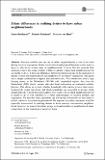Ethnic differences in realising desires to leave urban neighbourhoods
Abstract
Selective mobility into and out of urban neighbourhoods is one of the main driving forces of segregation. Earlier research has found group differences in who wants to leave or who leaves certain types of neighbourhoods. A factor that has received little attention so far is that some residents will have a desire to leave their neighbourhood, but are unable to do so. If there are differences between population groups in the realisation of desires to leave the neighbourhood, this might lead to involuntary segregation. This paper uses a unique combination of register data and survey data. We combine data from a large housing survey in the Netherlands (WoON) with longitudinal register data from the Netherlands (SSD) which contains individual-level information on residential mobility histories. This allows us to study whether households with a desire to leave their neighbourhood do realise this desire and which households are successful in leaving which neighbourhoods. A more thorough insight in who wants to leave which neighbourhoods but is unable to do so will contribute to a better understanding of selective mobility and segregation. We find that ethnic minorities and low-income households are less likely to realise a desire to leave their neighbourhood. We expected that ethnic minorities would be especially unsuccessful in realising desires to leave minority concentration neighbourhoods; however, for none of the ethnic groups we found an effect of neighbourhood ethnic composition on the realisation of desires to leave.
Citation
Boschman , S , Kleinhans , R & van Ham , M 2017 , ' Ethnic differences in realising desires to leave urban neighbourhoods ' , Journal of Housing and the Built Environment , vol. 32 , no. 3 , pp. 495-512 . https://doi.org/10.1007/s10901-016-9524-3
Publication
Journal of Housing and the Built Environment
Status
Peer reviewed
ISSN
1566-4910Type
Journal article
Description
The research leading to these results has received funding from the European Research Council under the European Union’s Seventh Framework Programme (FP/2007–2013)/ERC Grant Agreement no. 615159 (ERC Consolidator Grant DEPRIVEDHOODS, socio-spatial inequality, deprived neighbourhoods and neighbourhood effects) and from the Marie Curie programme under the European Union’s Seventh Framework Programme (FP/2007–2013)/Career Integration Grant no. PCIG10-GA-2011-303728 (CIG Grant NBHCHOICE, neighbourhood choice, neighbourhood sorting and neighbourhood effects).Collections
Items in the St Andrews Research Repository are protected by copyright, with all rights reserved, unless otherwise indicated.

